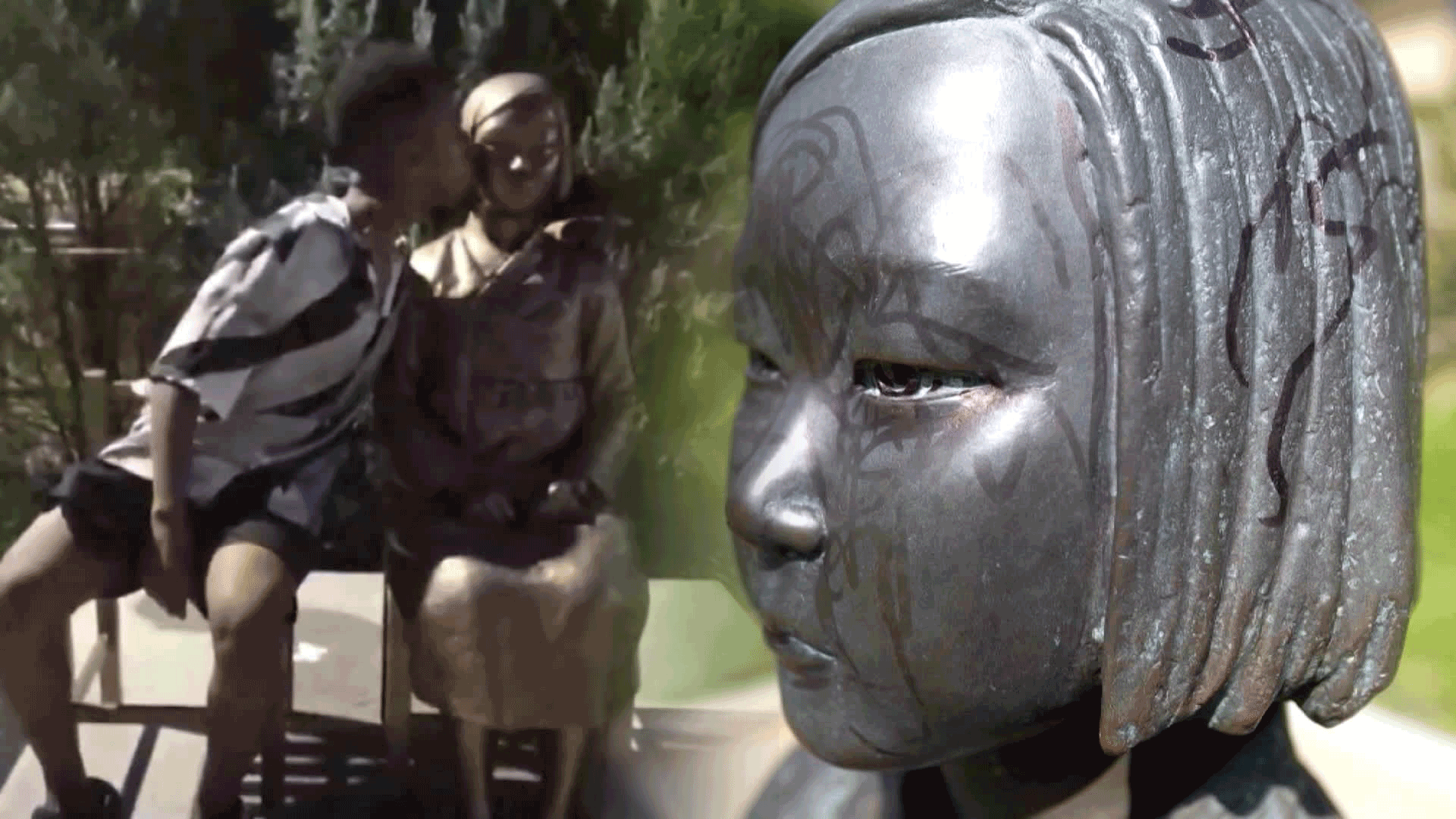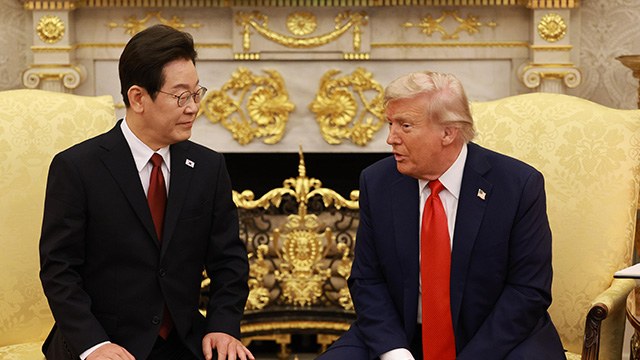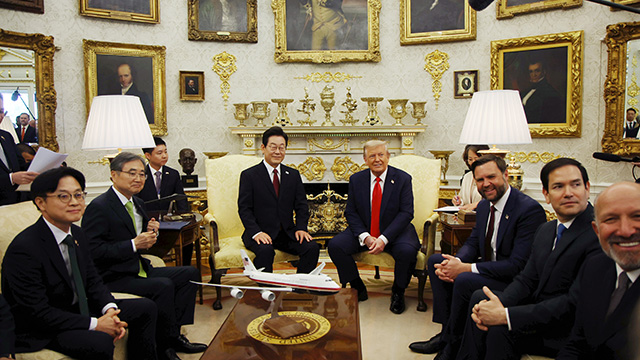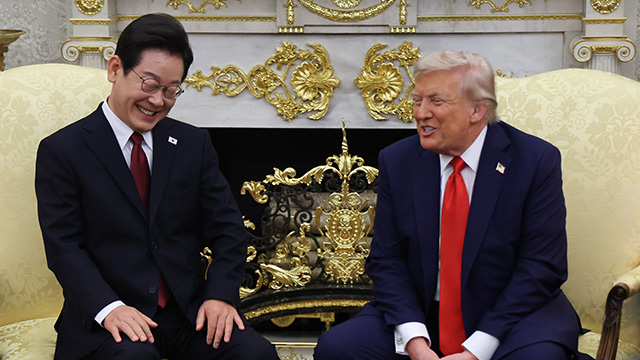Repeated attacks on Peace Statues
입력 2025.08.26 (00:08)
수정 2025.08.26 (00:09)
읽어주기 기능은 크롬기반의
브라우저에서만 사용하실 수 있습니다.
[Anchor]
The Statue of Peace, first erected in front of the Japanese Embassy in Korea in 2011, now has over 150 installations nationwide.
However, incidents of insult and vandalism, such as covering the statues with plastic on Liberation Day, are occurring one after another.
Reporter Kim Seong-soo has the details.
[Report]
The Statue of Peace in Yongsan, Seoul, was voluntarily created by citizens in 2017.
Last year, it was subjected to a malicious kiss by an American man.
In Busan, a man in his 30s was caught covering the statue with a large bag that had the word 'demolition' written in red.
This year, the statue in Ansan, Gyeonggi Province, was also covered with plastic on Liberation Day.
Despite the ongoing insults and vandalism against the statue, appropriate punishment is difficult to impose.
Covering it with plastic or spitting on it does not easily qualify as property damage, and the crime of insult applies to individuals, not to statues.
The law regarding comfort women victims does not even include provisions for punishment for defamation or insult.
Since the statue is classified as a simple sculpture, it typically results in minor offenses that only incur fines.
In response to concerns about its vulnerability, the Ministry of Gender Equality and Family conducted a survey last year and confirmed 155 statues nationwide.
However, no inspections regarding the condition of preservation, such as whether they have been vandalized, were conducted.
A bill to punish those who defame the statue or the honor of comfort women victims is still in the discussion stage in the National Assembly.
There are also calls for local governments to designate the statues as public sculptures for better management.
[Lee Won-young/Representative of Yongsan Citizens' Alliance/Establishment of the statue: "I believe that the government and local governments should manage them regularly, and there should definitely be provisions for punishment regarding the vandalism of such sculptures."]
The Ministry of Gender Equality and Family has announced plans to periodically check for any vandalism of the statues in the future.
This is KBS News, Kim Seong-soo.
The Statue of Peace, first erected in front of the Japanese Embassy in Korea in 2011, now has over 150 installations nationwide.
However, incidents of insult and vandalism, such as covering the statues with plastic on Liberation Day, are occurring one after another.
Reporter Kim Seong-soo has the details.
[Report]
The Statue of Peace in Yongsan, Seoul, was voluntarily created by citizens in 2017.
Last year, it was subjected to a malicious kiss by an American man.
In Busan, a man in his 30s was caught covering the statue with a large bag that had the word 'demolition' written in red.
This year, the statue in Ansan, Gyeonggi Province, was also covered with plastic on Liberation Day.
Despite the ongoing insults and vandalism against the statue, appropriate punishment is difficult to impose.
Covering it with plastic or spitting on it does not easily qualify as property damage, and the crime of insult applies to individuals, not to statues.
The law regarding comfort women victims does not even include provisions for punishment for defamation or insult.
Since the statue is classified as a simple sculpture, it typically results in minor offenses that only incur fines.
In response to concerns about its vulnerability, the Ministry of Gender Equality and Family conducted a survey last year and confirmed 155 statues nationwide.
However, no inspections regarding the condition of preservation, such as whether they have been vandalized, were conducted.
A bill to punish those who defame the statue or the honor of comfort women victims is still in the discussion stage in the National Assembly.
There are also calls for local governments to designate the statues as public sculptures for better management.
[Lee Won-young/Representative of Yongsan Citizens' Alliance/Establishment of the statue: "I believe that the government and local governments should manage them regularly, and there should definitely be provisions for punishment regarding the vandalism of such sculptures."]
The Ministry of Gender Equality and Family has announced plans to periodically check for any vandalism of the statues in the future.
This is KBS News, Kim Seong-soo.
■ 제보하기
▷ 카카오톡 : 'KBS제보' 검색, 채널 추가
▷ 전화 : 02-781-1234, 4444
▷ 이메일 : kbs1234@kbs.co.kr
▷ 유튜브, 네이버, 카카오에서도 KBS뉴스를 구독해주세요!
- Repeated attacks on Peace Statues
-
- 입력 2025-08-26 00:08:56
- 수정2025-08-26 00:09:11

[Anchor]
The Statue of Peace, first erected in front of the Japanese Embassy in Korea in 2011, now has over 150 installations nationwide.
However, incidents of insult and vandalism, such as covering the statues with plastic on Liberation Day, are occurring one after another.
Reporter Kim Seong-soo has the details.
[Report]
The Statue of Peace in Yongsan, Seoul, was voluntarily created by citizens in 2017.
Last year, it was subjected to a malicious kiss by an American man.
In Busan, a man in his 30s was caught covering the statue with a large bag that had the word 'demolition' written in red.
This year, the statue in Ansan, Gyeonggi Province, was also covered with plastic on Liberation Day.
Despite the ongoing insults and vandalism against the statue, appropriate punishment is difficult to impose.
Covering it with plastic or spitting on it does not easily qualify as property damage, and the crime of insult applies to individuals, not to statues.
The law regarding comfort women victims does not even include provisions for punishment for defamation or insult.
Since the statue is classified as a simple sculpture, it typically results in minor offenses that only incur fines.
In response to concerns about its vulnerability, the Ministry of Gender Equality and Family conducted a survey last year and confirmed 155 statues nationwide.
However, no inspections regarding the condition of preservation, such as whether they have been vandalized, were conducted.
A bill to punish those who defame the statue or the honor of comfort women victims is still in the discussion stage in the National Assembly.
There are also calls for local governments to designate the statues as public sculptures for better management.
[Lee Won-young/Representative of Yongsan Citizens' Alliance/Establishment of the statue: "I believe that the government and local governments should manage them regularly, and there should definitely be provisions for punishment regarding the vandalism of such sculptures."]
The Ministry of Gender Equality and Family has announced plans to periodically check for any vandalism of the statues in the future.
This is KBS News, Kim Seong-soo.
The Statue of Peace, first erected in front of the Japanese Embassy in Korea in 2011, now has over 150 installations nationwide.
However, incidents of insult and vandalism, such as covering the statues with plastic on Liberation Day, are occurring one after another.
Reporter Kim Seong-soo has the details.
[Report]
The Statue of Peace in Yongsan, Seoul, was voluntarily created by citizens in 2017.
Last year, it was subjected to a malicious kiss by an American man.
In Busan, a man in his 30s was caught covering the statue with a large bag that had the word 'demolition' written in red.
This year, the statue in Ansan, Gyeonggi Province, was also covered with plastic on Liberation Day.
Despite the ongoing insults and vandalism against the statue, appropriate punishment is difficult to impose.
Covering it with plastic or spitting on it does not easily qualify as property damage, and the crime of insult applies to individuals, not to statues.
The law regarding comfort women victims does not even include provisions for punishment for defamation or insult.
Since the statue is classified as a simple sculpture, it typically results in minor offenses that only incur fines.
In response to concerns about its vulnerability, the Ministry of Gender Equality and Family conducted a survey last year and confirmed 155 statues nationwide.
However, no inspections regarding the condition of preservation, such as whether they have been vandalized, were conducted.
A bill to punish those who defame the statue or the honor of comfort women victims is still in the discussion stage in the National Assembly.
There are also calls for local governments to designate the statues as public sculptures for better management.
[Lee Won-young/Representative of Yongsan Citizens' Alliance/Establishment of the statue: "I believe that the government and local governments should manage them regularly, and there should definitely be provisions for punishment regarding the vandalism of such sculptures."]
The Ministry of Gender Equality and Family has announced plans to periodically check for any vandalism of the statues in the future.
This is KBS News, Kim Seong-soo.
-
-

김성수 기자 ssoo@kbs.co.kr
김성수 기자의 기사 모음
-
이 기사가 좋으셨다면
-
좋아요
0
-
응원해요
0
-
후속 원해요
0















이 기사에 대한 의견을 남겨주세요.